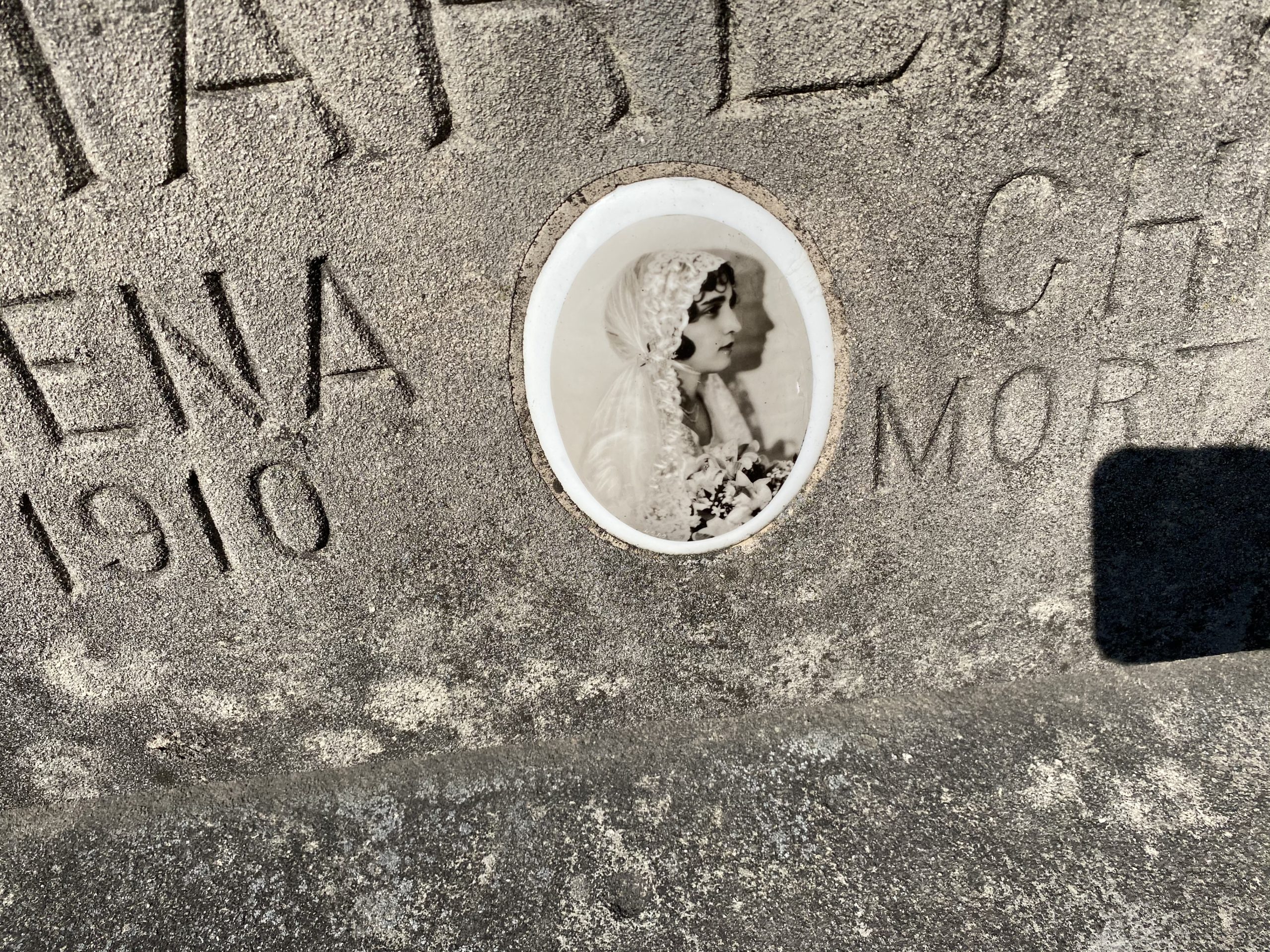1 January 1910 – 25 April 1930
This beautiful memorial follows the naturalistic tree stump style but with some unique flourishes. The bench is adorned with acorns, the symbolism nearly shouting about youth and promise of the young woman whose headstone this is, and Philomena’s story is especially tragic.
The oldest of five surviving children born to Italian immigrants Natale and Giuseppa “Josephine” Gaustella Dado, Philomena lost her mother at the age of seven. There is no cause of death but the timing of Giuseppa’s death coincides with both the early days of the Great Influenza and the birth of her youngest child. Giuseppa was only twenty-six years old. She is buried with her oldest child, a son named Alberto who was born exactly one year before Philomena and died seven months later.
Though Philomena’s father eventually remarried, it isn’t clear when (the census record for 1920 is fuzzy, stating that he is married but listing no wife) so it is probable Philomena had to pitch in and help care for her younger siblings at her own very young age. The 1930 census tells us that though she could read and write, she did not attend school, so it is likely she learned at hom from her mother and stepmother.
Though the Dado family moved from census to census, they always lived in the Brighton Park neighborhood which was a popular location for immigrants from Italy and other European countries. Natale worked as a self-employed contractor and seems to have been successful at it.
Though I can’t find a marriage record, from the newspaper coverage of her death, we know Philomena and her husband Matthew had only been married for five months at the time of her death which means they married in late 1929 when Philomena was just 19 years old. Her husband was ten years her senior and an Italian immigrant.
A week before her death, the census taker came by the couple’s lovely little house in the southwestern corner of Brighton Park. The census lists Matthew’s profession as furniture upholsterer, and he owned their house outright (I think the one at that address today dates back to at least the 1930s and if so: still there and darling). The home value is listed as $10K. It was to have been a very nice life for young Philomena, and I’m sure her father was happy to see her so well situated.
But a week later tragedy struck. Very early on April 24th, the same day the census taker would later arrive at her father and stepmother’s house, Philomena thought she heard a prowler. Matthew went to investigate and Philomena followed him downstairs. Apparently Matthew was unaware she had done this, for when he saw movement in the kitchen, he opened fire, mortally wounding Philomena.
A story about the incident that ran in the paper later the same day was blithe and victim-blamey, basically calling Philomena a silly girl imagining things and getting herself shot. The reporter seemed to think she would survive and clearly did not take the story seriously. The next day, however, the news of her tragic death ran in papers throughout the region.
The story feels a bit suspect to me, but with nothing but my reaction to the tone of the initial article to go on, we will leave it at that. It was an exceptionally dramatic time in Chicago, mid-Prohibition, the last days of Capone when he was already on the run, and in the early days of the Great Depression. A tragic tale of a beautiful young bride was I’m sure just seen as fodder for the papers.
 On 25 April, Philomena died of her wounds and was buried with this beautiful memorial in Mount Carmel. As I didn’t know her maiden name at the time, I wouldn’t have connected any Dado headstones to her, so I’m not certain if her parents and brother are buried nearby, but they are all at Mount Carmel. Matthew remarried and had at least one child, a daughter. He lived to be 93 and is buried in California.
On 25 April, Philomena died of her wounds and was buried with this beautiful memorial in Mount Carmel. As I didn’t know her maiden name at the time, I wouldn’t have connected any Dado headstones to her, so I’m not certain if her parents and brother are buried nearby, but they are all at Mount Carmel. Matthew remarried and had at least one child, a daughter. He lived to be 93 and is buried in California.
Philomena is not mentioned in either her husband’s or her father’s obituaries, but her closest-in-age sibling, Mary, mentions her “dear sister” in her own obituary published 63 years after Philomena’s death. Whether Mary wrote up her own list of people to be remembered prior to her death, or she spoke often of Philomena and her children made sure to mention their long-dead aunt as dear to their mother, Philomena’s memory endured.
RIP Philomena
Please visit my Instagram for any questions or comments on this post!
